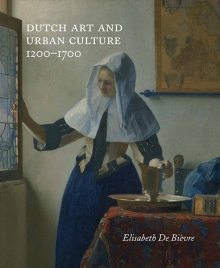After completing her 1986 doctoral dissertation on the decoration of town halls in the United Provinces, Elisabeth de Bièvre published a series of studies (notably “The Urban Subconscious: The Art of Delft and Leiden” Art History, 18, 2 (1995), 222-252) that stressed the importance of distinctive urban traditions in the development of Dutch art. These pieces challenged the widely-held view that seventeenth-century artists travelled easily – often on the trekschuit network – between towns, exchanged ideas constantly, and were able to move outside the local traditions that governed late medieval art in the Low Countries. In her ambitious new book, the author maintains this general theme while markedly expanding her horizons. Looking at the period between 1200-1700, she argues for a degree of continuity in local customs over the entirety of that long span, countering others who would argue for a distinctive break with tradition in the late sixteenth and early seventeenth centuries. Her view seems to me to be a very important element in our understanding of the Golden Age, even if she occasionally expresses it in too polemical a tone.
Dr. De Bièvre’s method is original and effective. She chooses seven cities on which to focus – The Hague, Dordrecht, Haarlem, Delft, Leiden, Amsterdam and Utrecht – appointing a painting as an “urban ambassador” for each locale: Adriaen van de Venne’s Cavalcade of the Princes for The Hague, Aelbert Cuyp’s Avenue at Meerdervoort for Dordrecht, Gerrit van Honthorst’s Granida and Daifilo for Utrecht, and so on. They are well-chosen examples and make the point concisely. She then outlines the geography, political history, economic circumstances and religious affiliations of each of her chosen cities with a special emphasis on late medieval traditions of civic independence. Although much of the ground she covers is familiar to specialists, her historical narrative is engaging and provides a very useful introduction to the general reader.
De Bièvre holds that local civic traditions – their importance and continuity – were major factors in the extraordinary development of art and architecture in the Dutch Republic in the seventeenth century. Her position is a valuable corrective to the prevailing view. As might be expected, the argument works better for some cities than for others. It is most persuasive with respect to The Hague and Utrecht, which stand as bookends to her account: no one would deny that the presence of the court in The Hague and the Catholic heritage of Utrecht had a profound effect of the art which the cities produced. The argument for Haarlem, however, is less easy to make as there were so many immigrant artists early in the seventeenth century who shaped the course of painting in that town. Amsterdam, the great metropolis which attracted artists from throughout the Republic and beyond, evades any form of classification. Nonetheless, the author makes her argument well and provides a lively account of the importance of localism in Dutch art. The book is beautifully produced by Yale University Press, with excellent, well-chosen color illustrations and a very attractive lay-out.
Christopher Brown
University of Oxford
